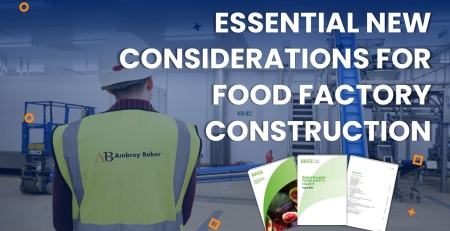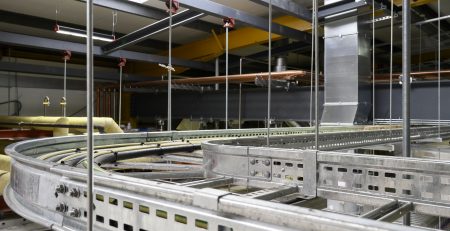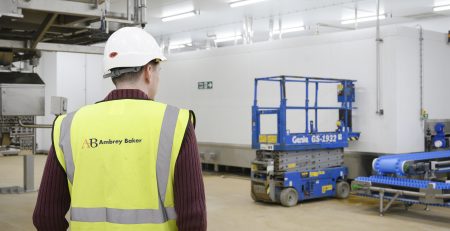A new era in fire safety
Covid-19 has already proved to have an impact on the way we shop. As the safest way to get goods, online shopping continues to be preferred by most. Particularly when it comes to getting groceries and avoiding busy supermarkets.
This means that the production facilities and factories that underpin the e-commerce FMCG sector are more vital than ever before. Fires in these spaces have the potential to be even more detrimental. As well as posing a threat to life, fires can devastate business operations. They massively disrupt the supply chain and lead to the loss of jobs and productivity.
Luckily, there are many additional measures to improve fire safety and protect your facility.
What causes factory fires?
There are several common causes of fires. The most frequent cause is arson, though many other causes can be preventable with the correct infrastructure:
- Electrical faults: Issues with electrical installations are the second largest cause of factory and warehouse fires.
- Heating equipment: Around 8% of industrial fires are caused by heating equipment. Poor placement and careless usage contribute to the danger.
- Exposure: Combustible materials are another common cause of fires. Facilities managers must review the risk category of goods stored and not overlook the nature of packaging materials. Common packaging materials – cardboard, plastic, and polystyrene are particularly flammable.
The lack of space and the age of existing facilities also means that often accessibility is impeded. In 12% of fires investigated by the FPA, fire and rescue services were obstructed in their ability to put out fires due to poor vehicle access to the front of a building.
Food factory challenges
The Grenfell fire disaster has increased awareness of the duty of care across all sectors. Both in terms of new competency, risk management and insurance requirements.
Food processing facilities, and their cold and chilled storage equipment, are especially impacted. This is due to the nature of materials used now being classified as a heightened fire risk. Polystyrene is a common core material within composite panels used for the walls and ceilings food safe environments. It is now largely outlawed by the insurance market. Under the Health and Safety at Work etc Act 1974, those in control of premises (landlords and tenants) are being challenged by both regulators and insurers to replace all such materials within their property portfolios, regardless of the expense.
One should also be mindful of the dry atmospheric conditions within many types of food factories and temperature-controlled spaces because the evaporative condensers used to sustain the low temperatures remove air moisture to very low levels of humidity which would accelerate the spread of flame too if there were to be a fire to break out.
Other anomalies concerning these spaces are the ceiling voids above the temperature-controlled boxes, which can become a random storage area for operators’ effects such as office filing, etc. Contractors undertaking works in voids should not use any form of “hot working”.
Smoke curtains in the ceiling voids are often cut through for new building services or processes below, compromising fire integrity and risk.
Fire doors and the integrity of smoke and fire seals often need regular inspection and replacement because of operational wear & tear. These and the aforementioned void space status and materials risk should be inspected as part of the regular fire risk audit process.
What can businesses do to prevent fires?
With all this said, a business can implement plenty of additional precautions to prevent fire hazards in the workplace and ensure the safety of all.
There are many things that businesses can be to minimise their risk of fire:
- Firewalls: The installation of firewalls, alongside these other considerations, is a very cost-effective solution to managing risk. Firewalls made to the highest specifications, allow you to control the uncontrollable and give yourself additional reassurance.
- Risk assessments: It’s a legal requirement to carry out a fire risk assessment under The Regulatory Reform (Fire Safety) Order 2005. It is also worth having further independent audits by consultants and insurers who assist with fire strategy and associated mitigations. These audits include door and roof surveys. These can be carried out regularly to identify the fire integrity of existing doors throughout a site. This allows you to find faults for each door and fire escape route. This also applies to the structural integrity of roof void panels throughout sites.
- Automatic Fire Detection: Ensure that detectors are installed across your warehouse facility. Make sure you’re paying special attention to areas that may be more vulnerable to a fire or more volatile goods stored. There are numerous types: Thermal Imaging; Flame Detection; Spark Detection; Ember Detection; Rate of Rise of Heat Detection; and Addressable Linear Detection.
What next?
The stakes are high for food factory businesses and logistics companies operating in FMCG e-commerce, particularly cold and chill storage. The impact of a fire can have catastrophic impacts in terms of loss of life and business disruption.
Firms with better-protected assets are more likely to be compliant. Increased levels of compliance will benefit from more favourable insurance premiums and possess an advantage when negotiating new contracts with customers.
To get help from our experts with your fire safety, get in touch today at enquiries@ambreybakerconstruction.co.uk or follow us on LinkedIn.












Comments (59)
Can you be more specific about the content of your article? After reading it, I still have some doubts. Hope you can help me. https://accounts.binance.com/es/register?ref=T7KCZASX
I don’t think the title of your article matches the content lol. Just kidding, mainly because I had some doubts after reading the article.
I don’t think the title of your article matches the content lol. Just kidding, mainly because I had some doubts after reading the article.
Nice post. I learn something more challenging on different blogs everyday. It will always be stimulating to read content from other writers and practice a little something from their store. I’d prefer to use some with the content on my blog whether you don’t mind. Natually I’ll give you a link on your web blog. Thanks for sharing.
Today, I went to the beach with my kids. I found a sea shell and gave it to my 4 year old daughter and said “You can hear the ocean if you put this to your ear.” She placed the shell to her ear and screamed. There was a hermit crab inside and it pinched her ear. She never wants to go back! LoL I know this is completely off topic but I had to tell someone!
I am glad to be a visitor of this double dyed website! , appreciate it for this rare information! .
Hello there, just became alert to your blog through Google, and found that it is truly informative. I’m gonna watch out for brussels. I will be grateful if you continue this in future. Lots of people will be benefited from your writing. Cheers!
Thanks for sharing. I read many of your blog posts, cool, your blog is very good.
Nice post. I learn something more challenging on different blogs everyday. It will always be stimulating to read content from other writers and practice a little something from their store. I’d prefer to use some with the content on my blog whether you don’t mind. Natually I’ll give you a link on your web blog. Thanks for sharing.
Hello, you used to write fantastic, but the last few posts have been kinda boring… I miss your great writings. Past few posts are just a little bit out of track! come on!
My brother suggested I might like this blog. He was entirely right. This post truly made my day. You can not imagine just how much time I had spent for this information! Thanks!
hi!,I really like your writing so much! proportion we keep up a correspondence extra about your article on AOL? I require a specialist in this area to resolve my problem. Maybe that’s you! Having a look forward to see you.
Good V I should definitely pronounce, impressed with your site. I had no trouble navigating through all tabs as well as related info ended up being truly easy to do to access. I recently found what I hoped for before you know it in the least. Quite unusual. Is likely to appreciate it for those who add forums or something, site theme . a tones way for your client to communicate. Nice task..
I was just seeking this info for some time. After 6 hours of continuous Googleing, finally I got it in your web site. I wonder what’s the lack of Google strategy that don’t rank this kind of informative sites in top of the list. Generally the top sites are full of garbage.
I believe you have observed some very interesting points, thanks for the post.
F*ckin¦ awesome things here. I am very glad to look your article. Thank you a lot and i’m looking ahead to contact you. Will you please drop me a e-mail?
You got a very excellent website, Gladiola I observed it through yahoo.
Great post. I used to be checking constantly this weblog and I’m inspired! Very useful information specially the last section 🙂 I take care of such information much. I was seeking this certain info for a long time. Thank you and good luck.
Somebody essentially help to make seriously posts I would state. This is the first time I frequented your web page and thus far? I surprised with the research you made to create this particular publish extraordinary. Magnificent job!
I believe other website proprietors should take this website as an example , very clean and great user genial design.
As I website owner I believe the written content here is real excellent, regards for your efforts.
Thanks a lot for sharing this with all of us you actually know what you are talking about! Bookmarked. Please also visit my site =). We could have a link exchange contract between us!
You really make it appear really easy with your presentation but I find this matter to be really one thing that I feel I’d by no means understand. It seems too complex and very broad for me. I’m having a look ahead in your next put up, I?¦ll try to get the hang of it!
he blog was how do i say it… relevant, finally something that helped me. Thanks
Thanks for sharing. I read many of your blog posts, cool, your blog is very good.
Explore a wide range of unique cycling gear, including jerseys, bib shorts, and custom designs. Perfect for every cyclist, from casual riders to pros. High-quality materials, standout designs, and options for personalization make it easy to find the perfect fit for you or your team. Shop now and ride in style!
F*ckin¦ remarkable things here. I am very happy to see your post. Thanks so much and i am looking forward to contact you. Will you kindly drop me a e-mail?
I wish to convey my respect for your kind-heartedness giving support to persons who actually need assistance with this content. Your very own commitment to getting the solution all around had become surprisingly practical and has specifically allowed men and women just like me to attain their targets. Your important help and advice indicates a great deal a person like me and extremely more to my mates. Regards; from everyone of us.
You got a very excellent website, Glad I observed it through yahoo.
I am also writing to let you understand of the beneficial discovery my cousin’s daughter enjoyed checking your web page. She noticed so many things, which include what it’s like to possess an amazing helping character to make others just comprehend certain tricky topics. You truly surpassed her expectations. Thank you for distributing the important, trusted, edifying and even unique thoughts on the topic to Julie.
Having read this I thought it was very informative. I appreciate you taking the time and effort to put this article together. I once again find myself spending way to much time both reading and commenting. But so what, it was still worth it!
Undeniably believe that which you stated. Your favorite justification appeared to be on the net the simplest thing to be aware of. I say to you, I definitely get annoyed while people think about worries that they just don’t know about. You managed to hit the nail upon the top and also defined out the whole thing without having side effect , people could take a signal. Will likely be back to get more. Thanks
After examine a number of of the blog posts in your web site now, and I truly like your method of blogging. I bookmarked it to my bookmark website list and might be checking again soon. Pls take a look at my web site as effectively and let me know what you think.
I love your blog.. very nice colors & theme. Did you create this website yourself? Plz reply back as I’m looking to create my own blog and would like to know wheere u got this from. thanks
It’s hard to find knowledgeable people on this topic, but you sound like you know what you’re talking about! Thanks
I loved as much as you’ll receive carried out right here. The sketch is tasteful, your authored material stylish. nonetheless, you command get bought an nervousness over that you wish be delivering the following. unwell unquestionably come further formerly again as exactly the same nearly a lot often inside case you shield this hike.
There is visibly a bunch to realize about this. I assume you made certain nice points in features also.
I’m often to running a blog and i really appreciate your content. The article has actually peaks my interest. I’m going to bookmark your website and preserve checking for brand new information.
Very interesting topic, thank you for posting.
CSGORoll is the best CS2 gambling site in United Kingdom that offers a wide variety of virtual games that use CS:GO skins as currency.
Its like you learn my thoughts! You seem to understand a lot approximately this, such as you wrote the e book in it or something. I think that you just can do with some p.c. to pressure the message home a bit, however instead of that, this is wonderful blog. A fantastic read. I will definitely be back.
I have read several just right stuff here. Certainly value bookmarking for revisiting. I surprise how so much attempt you set to make one of these excellent informative web site.
I am often to blogging and i really appreciate your content. The article has really peaks my interest. I am going to bookmark your site and keep checking for new information.
Along with every little thing that seems to be developing inside this subject matter, all your points of view are generally fairly refreshing. Nonetheless, I am sorry, because I do not subscribe to your entire strategy, all be it exhilarating none the less. It would seem to everyone that your commentary are actually not entirely justified and in fact you are your self not really thoroughly confident of your argument. In any case I did enjoy looking at it.
Hello my friend! I wish to say that this post is amazing, nice written and include almost all important infos. I would like to see more posts like this.
Magnificent beat ! I would like to apprentice while you amend your website, how could i subscribe for a blog site? The account aided me a acceptable deal. I had been a little bit acquainted of this your broadcast offered bright clear idea
Very interesting subject , thanks for putting up.
You have remarked very interesting points! ps decent internet site.
Hello there, just become alert to your weblog through Google, and found that it is truly informative. I’m going to watch out for brussels. I will appreciate if you proceed this in future. Numerous other people can be benefited from your writing. Cheers!
I am not really fantastic with English but I find this rattling easygoing to read .
This website is my inhalation, really good pattern and perfect content.
There’s noticeably a bundle to know about this. I assume you made certain nice factors in options also.
hello there and thank you for your information – I have certainly picked up anything new from right here. I did however expertise several technical points using this web site, as I experienced to reload the website a lot of times previous to I could get it to load properly. I had been wondering if your web hosting is OK? Not that I’m complaining, but sluggish loading instances times will sometimes affect your placement in google and can damage your quality score if ads and marketing with Adwords. Well I’m adding this RSS to my e-mail and can look out for a lot more of your respective exciting content. Make sure you update this again very soon..
What’s Going down i’m new to this, I stumbled upon this I have discovered It positively useful and it has aided me out loads. I’m hoping to contribute & help different users like its aided me. Great job.
I like what you guys are up too. Such intelligent work and reporting! Keep up the superb works guys I¦ve incorporated you guys to my blogroll. I think it’ll improve the value of my site 🙂
My Home Heating are boiler servicing experts in Tewkesbury Gloucestershire. we specialise in bringing warmth and comfort to homes across Tewkesbury and the surrounding areas. As your local heating experts, we take pride in delivering high-quality solutions for all your home heating needs. Whether you’re a homeowner or property manager, our skilled team is dedicated to ensuring your heating systems are safe, efficient, and reliable.
Beauty Clinic London is the place where you can get a wide range of beauty services. We offer a variety of facial and body treatments including massage, facial cleansing, laser hair removal and injectable techniques.
Its like you learn my mind! You seem to understand so much approximately this, like you wrote the e book in it or something. I think that you just can do with some p.c. to force the message home a little bit, however other than that, this is fantastic blog. A fantastic read. I will certainly be back.
I’d must examine with you here. Which isn’t one thing I normally do! I take pleasure in studying a post that may make people think. Also, thanks for permitting me to remark!